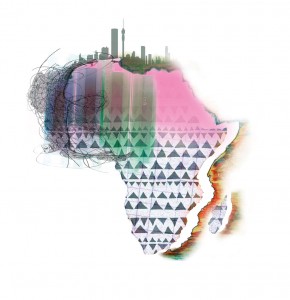Both Nollywood and Bollywood produce more films than Hollywood. But at the Cannes Festival, there was barely a single film that was not from any western-world country. Camilla Göth, a writer on cultural matters, wonders for how long the western world can continue to speak warmly about the subject of globalisation, but still close the door on cultures other than its own.
A few days ago, one of the most important happenings in the film industry was brought to a close – the Cannes Festival. Many of the big guns of the film industry were gathered, and films from France, the USA, England, Norway, Australia, and Argentina, among others, were screened. There was a single film that was made in Africa, a continent consisting of 55 countries. It is called Oka, and was produced in Mali.
The low number might seem startling, considering the fact that Swedes make 40 million travels where sleeping accommodation is included. The fact that we talk a lot more about our travelling further away makes the globalisation phenomenon seem limitless. The fact that our own economic growth will also stir the pot over there.
It is also peculiar to see how closely connected the cultures of the former colonies in north-western Africa are with France after the colonisation, but that film productions with solely North African filming crews receive a lot less attention than those with filming crews that are also supported by a French team. The award-winning film Timbuktu, from 2014, is one example of such a production.
Ten years ago, the Kenyan author and journalist, Binyavanga Wainaina, published the very satirical text “How to write about Arica” in the periodical Granta. Wainaina directs a critique, which is still of great immediate interest, towards western media, when he writes:
“[T]reat Africa as if it were one country. It is hot and dusty with rolling grasslands and huge herds of animals and tall, thin people who are starving”.
Thus, it is not merely important to let the African continent have a say and give it space in media and the society, it is equally as important how the continent is portrayed.
Mikela Lundahl exemplifies Wainaina’s critique in her article Kvinnor, vithet och de andras litteratur (Women, whiteness, and the others’ literature) which appeared in Tidsskrift för genusvetenskap (Gender research periodical,1-2: 2010). She investigated how African literature is depicted in media and on publishers’ websites. The results show that especially female African writers and their productions are often described as anti-patriarchal and anti-colonial. A picture that is not only one-sided but one that oftentimes is erroneous as well.

Chimamanda Ngozi Adichie is a clear example of this. In the last few years, her books have continuously been at the top of best-seller lists in Sweden, most recently with her book Americanah. Her books are often described as anti-colonial, despite the fact that they are seldom explicitly political, although Adichie, through the stories she tells, is confronting the westernised picture of Nigeria.
Although the picture of Africa is closer to a growing continent rather than a starving one today, the picture of it as the Other still exists. Both in my mind, as well as in many others’. Before my first visit to a development country, I thought a lot about the fact that I did not want to be the person Wainaina describes. My trip took me to Tanzania, and I was to do field studies. I ploughed through books, films, music, and research, to create a fairly truthful picture of the country. For one month, I lived in the town called Babati, and it happened more than once that I found myself in the only club in the town and the late hour almost always turned to four in the morning. It was euphoric dance, sweat and youngsters jumping and singing.
Part of me was quite surprised to experience the partying. The fact that it reminded me oh so much about when I am in a club somewhere in Sweden. In some way, I still believed that Africa was mostly steppes and plains. Not beer and dancing till dawn. It became evident that I was in a country, and in a part of the world, about which I had been fed a skewed information my whole life.
Films and art from other countries than those we define as Western has not entered the best room yet, but there are signs that something is happening. Cinemafrica is the biggest Nordic film festival devoted solely to African films. The festival takes place in Stockholm, and this year is the first time it is not compressed into a four-day festival, but is instead running for the whole year.
Cinema Indien is another film festival that took place for the second time this year, also in Stockholm. The goal was to challenge the idea that Indian films are only singing and dancing. Among other films, Mary Kom, a film about a young, Indian, female boxer, was screened. And at the same time, about 50 new films are produced in Nollywood, the enormous film industry of Nigeria, each week. That is more films produced per week compared with the production rate of Hollywood.
But in a post-colonial world, these things pass most people by.
Instead, they end up in a dark shadow in favour of oil-findings in Africa that become high-priority news, since they generate expectations with respect to economic growth.
Another example is the biased reporting around the ebola-catastrophe, which seems to have hit all of Africa, when, instead, it concerns a limited number of countries. And no one really thinks about the consequences.
The problem very much lies in what Chimamanda Ngozi Adichie puts her finger on in her Ted-talk, The danger of a single story, which has received a lot of attention. She thinks that when we acquaint ourselves with only one picture of a country, the picture remains incomplete.
Most countries in Africa and Asia are not automatically sent off to a financial and political corner anymore, but they are put in a cultural corner instead. And as long as the Cannes Festival does not take any responsibility, the colonial logic and ‘the Other’ will continue to exist, and Wainaina’s critique will continue to be relevant. Just as Mikela Lundahl states, the world needs colonial logic to feed on. It is, quite simply, essential in maintaining the structures that ‘the Other’ recreates, and to preserve the identity of “us” contra the Others.
The colonial expressions have other forms, and can sometimes be harder to identify than earlier. But we do the same thing as we have done before – repackage a neo-colonial fantasy of the world, and recreate the picture of the Other.






